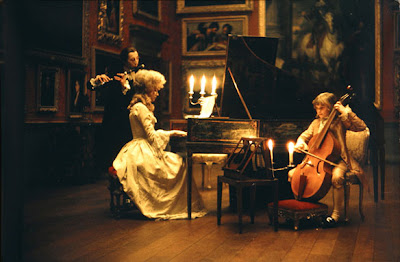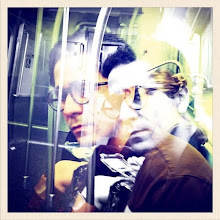
In an interview with Michel Ciment for L’Express, Stanley Kubrick said the following regarding his preparation for Barry Lyndon:
On Barry Lyndon, I accumulated a very large picture file of drawings and paintings taken from art books. These pictures served as the reference for everything we needed to make -- clothes, furniture, hand props, architecture, vehicles, etc. Unfortunately, the pictures would have been too awkward to use while they were still in the books, and I'm afraid we finally had very guiltily to tear up a lot of beautiful art books. They were all, fortunately, still in print, which made it seem a little less sinful. Good research is an absolute necessity and I enjoy doing it. You have an important reason to study a subject in much greater depth than you would ever have done otherwise, and then you have the satisfaction of putting the knowledge to immediate good use.
The background of the film as extensively incorporates a matrix of pictures of paintings as it does the novel by Thackeray. Kubrick tore scenes from European painting and reconfigured them to film. And the most immediate evocation of portraiture in the film is the sheer painted look of many scenes. As I have previously described, the Zeiss lens, adapted to the cinema camera, allowed Kubrick to emulate, by candlelight and dull light streaming through windows, the reduced depth of field, and subdued strength of light, in paintings by Caravaggio and the followers of his chiaroscuro, which include the Utrecht Caravaggisti (Gerrit van Honthorst, Hendrick Terbrugghen, et al.), who would later influence Gerard Dou and, more importantly, Vermeer, but also Georges de La Tour.

The Caravaggisti scenes in Barry Lyndon include the candlelit gambling sessions, Barry’s card game with Nora, his meeting in the tent with Captain Grogan, his seductive dinner with Lischen, the lonely German mother, his initial and ill-fated evening with Captain Potzdorf, in addition to a number scenes in Barryville and at Lady Lyndon’s castle, etc. In these scenes, there is scarcely an abrupt movement. Although they breathe with dialogue and exposition, that breath is never heaved. The still, muted effect is emphasized in a scene where, just after Lady Lyndon catches Barry in the garden with one of her maids, she is shown in her tub, half-naked and in an immobile stupor. Her body and face shine dully with an oiled stillness. She stares blankly through some unknown thought. The camera pulls away and she does not move. We are looking at an embodiment of flat elegance—-of painting. She is elsewhere described by the narrator as occupying a place “not very much more important than the elegant carpets and pictures, which would form the pleasant background of [Barry’s] existence.” Her muteness does not exactly register as intelligible dullness. She is rather subsumed into the film’s flatness of field. The field, as I have previously said, suggests a certain emotive corollary to a psychological register of flatness. Like the troubled scene in Balzac’s Unknown Masterpiece, the personhood of subject is lost in the reverie of portraiture. Lady Lyndon lives and breathes, and is fundamentally engaged in the actions of the film, but simultaneously absorbed in the portraiture of scenes, as flat as the frozen moment in which we see Barry depart into his carriage.





No comments:
Post a Comment